A Championship-specific mailbag! Right here! A second-tier league full of top-tier entertainment. Questions were asked, answers will follow. https://twitter.com/DavidAnderson_1/status/1224341362335764486 This year, Brentford are different. Rewind to any debate about the Bees in the last three or four seasons and without fail you’d hear something along the lines of 'fantastic to watch, great play in the final third, too soft at the back'. Over the previous three seasons — in which they’ve fallen just short of the play-offs — Brentford conceded 1.41, 1.13 and 1.28 goals per game respectively. This season it’s 0.76 per game. Their record of 23 goals conceded in 30 games makes them the meanest defence in the entire league. Even though the first two-thirds of a season have established that Brentford are a solid outfit now, it doesn’t make it any less weird. At any rate, to answer the question, let’s compare last season’s defensive radar with the same template from this season. 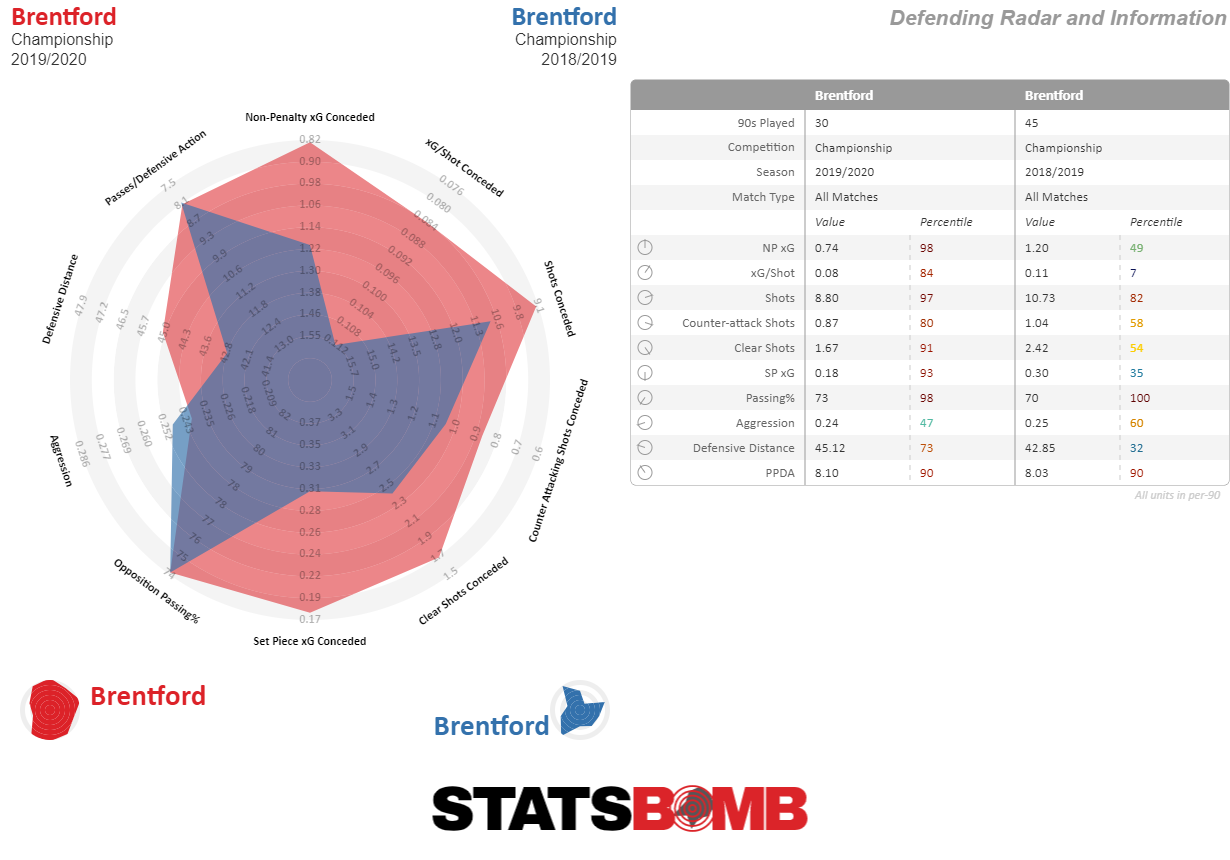 Seems conclusive. When looking at these figures you can, by a rule of thumb, consider the data points on the left to be ‘process’ indicators and the data points on the right to be ‘outcome’ indicators. The only difference between last season and this season in the ‘process’ category is defensive distance, which shows Brentford are performing defensive actions just over two metres higher up the pitch on average compared to last season. But that doesn’t explain the vast reduction in the quality of chances that Brentford give up. If anything, one could make the opposite argument that defending even further up the pitch should lead to more space behind the defence, which should lead to more counter-attacking opportunities for the opponent. That their passes per defensive action (PPDA), aggression (the portion of opponent passes they aggressively press), and opponent pass completion percentage all remain around the same level is curious. All of this leads me to one, un-video verified, conclusion: Brentford are simply more organised and coordinated in their pressing and their out of possession shape this season. Fewer gaps and spaces are left for the opposition to expose and play into. A tick in the coaching box for Thomas Frank. The other way in which Brentford have improved is that they’ve chopped 0.12 expected goals per game off their set-piece xG conceded, which works out to 5–6 goals a season. This could well be a tick for Pontus given his aerial prowess but the summer appointment of Head of Set Pieces Andreas Georgson probably has more to do with it. Overall, the Bees' improvement at the back, their ability to retain their attacking power and yet another summer of successful player trading is to be applauded, for sure. It’s impossible to see anything less than a play-off finish for Brentford, and it could feasibly be even more. https://twitter.com/chrisbelmore/status/1224354837120184323?s=20 The first caveat is one that isn't new, nor is it popular, but it's important to put Derby's season in context. Last season, they were just a top-six side, and it was a season-long overperformance — particularly late on — of their expected goals numbers that helped them finish even that high.
Seems conclusive. When looking at these figures you can, by a rule of thumb, consider the data points on the left to be ‘process’ indicators and the data points on the right to be ‘outcome’ indicators. The only difference between last season and this season in the ‘process’ category is defensive distance, which shows Brentford are performing defensive actions just over two metres higher up the pitch on average compared to last season. But that doesn’t explain the vast reduction in the quality of chances that Brentford give up. If anything, one could make the opposite argument that defending even further up the pitch should lead to more space behind the defence, which should lead to more counter-attacking opportunities for the opponent. That their passes per defensive action (PPDA), aggression (the portion of opponent passes they aggressively press), and opponent pass completion percentage all remain around the same level is curious. All of this leads me to one, un-video verified, conclusion: Brentford are simply more organised and coordinated in their pressing and their out of possession shape this season. Fewer gaps and spaces are left for the opposition to expose and play into. A tick in the coaching box for Thomas Frank. The other way in which Brentford have improved is that they’ve chopped 0.12 expected goals per game off their set-piece xG conceded, which works out to 5–6 goals a season. This could well be a tick for Pontus given his aerial prowess but the summer appointment of Head of Set Pieces Andreas Georgson probably has more to do with it. Overall, the Bees' improvement at the back, their ability to retain their attacking power and yet another summer of successful player trading is to be applauded, for sure. It’s impossible to see anything less than a play-off finish for Brentford, and it could feasibly be even more. https://twitter.com/chrisbelmore/status/1224354837120184323?s=20 The first caveat is one that isn't new, nor is it popular, but it's important to put Derby's season in context. Last season, they were just a top-six side, and it was a season-long overperformance — particularly late on — of their expected goals numbers that helped them finish even that high. 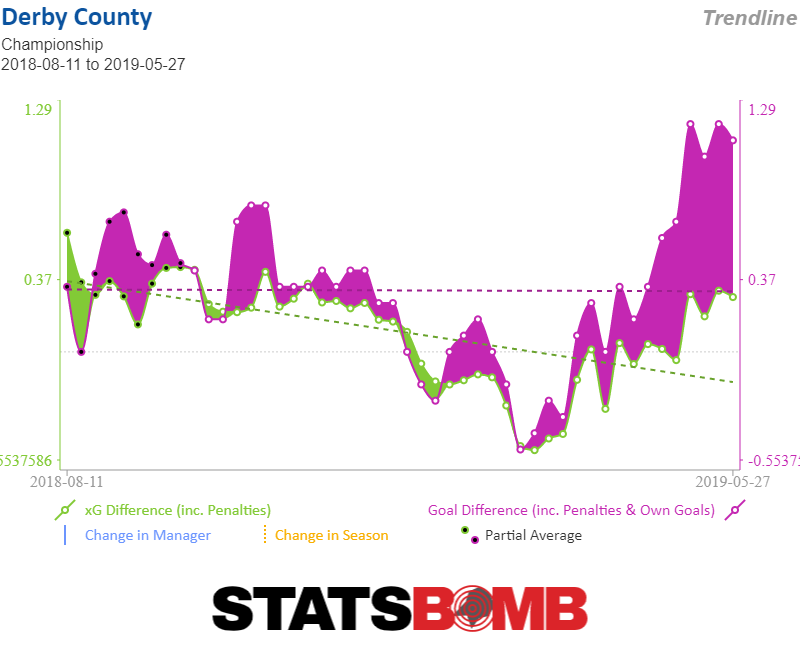 As Chris points out, after removing the now-established Premier League talent of Fikayo Tomori, Mason Mount and Harry Wilson from the side, the team were already working off a much weaker base going into this season. A team that was barely a top-six Championship side now most certainly wouldn't finish that high unless Derby could repeat the trick of recruiting well to replace the quality lost, which was always going to be difficult to do. Factor in the literal rap sheet of bad off-field behavior — which seems to pile in on a monthly basis — and the foundations simply aren’t there for the team to mount a promotion bid. For me, Cocu gets a free pass on that. Given that Derby were reliant on the aforementioned loan signings to reach the top six last season, it’s clear the squad's foundations did not rise to that level without those players, and therefore a squad rebuild was/is required. Before a squad really takes on the manager's image, the club needs three (at minimum) transfer windows to find the right players. One feather in Cocu’s cap is that in the absence of incoming replacements, he’s integrated more academy products to the team. In addition to last season’s standouts, Jayden Bogle. Jason Knight and Max Lowe, who are getting regular minutes, several more linger on the fringes, in position to break through over the next couple of seasons. The introduction of these players — assuming they are of sufficient quality, which early indicators suggest they may well be — will save Derby money in the transfer market or could help to fund their rebuild if these players progress faster than the club and move on to the Premier League (cough, Bogle, cough). On the pitch, it was a pretty underwhelming start, but the stats indicate their performances are moving in the right direction, although the recent run of good form has come on a ridiculously soft set of fixtures.
As Chris points out, after removing the now-established Premier League talent of Fikayo Tomori, Mason Mount and Harry Wilson from the side, the team were already working off a much weaker base going into this season. A team that was barely a top-six Championship side now most certainly wouldn't finish that high unless Derby could repeat the trick of recruiting well to replace the quality lost, which was always going to be difficult to do. Factor in the literal rap sheet of bad off-field behavior — which seems to pile in on a monthly basis — and the foundations simply aren’t there for the team to mount a promotion bid. For me, Cocu gets a free pass on that. Given that Derby were reliant on the aforementioned loan signings to reach the top six last season, it’s clear the squad's foundations did not rise to that level without those players, and therefore a squad rebuild was/is required. Before a squad really takes on the manager's image, the club needs three (at minimum) transfer windows to find the right players. One feather in Cocu’s cap is that in the absence of incoming replacements, he’s integrated more academy products to the team. In addition to last season’s standouts, Jayden Bogle. Jason Knight and Max Lowe, who are getting regular minutes, several more linger on the fringes, in position to break through over the next couple of seasons. The introduction of these players — assuming they are of sufficient quality, which early indicators suggest they may well be — will save Derby money in the transfer market or could help to fund their rebuild if these players progress faster than the club and move on to the Premier League (cough, Bogle, cough). On the pitch, it was a pretty underwhelming start, but the stats indicate their performances are moving in the right direction, although the recent run of good form has come on a ridiculously soft set of fixtures. 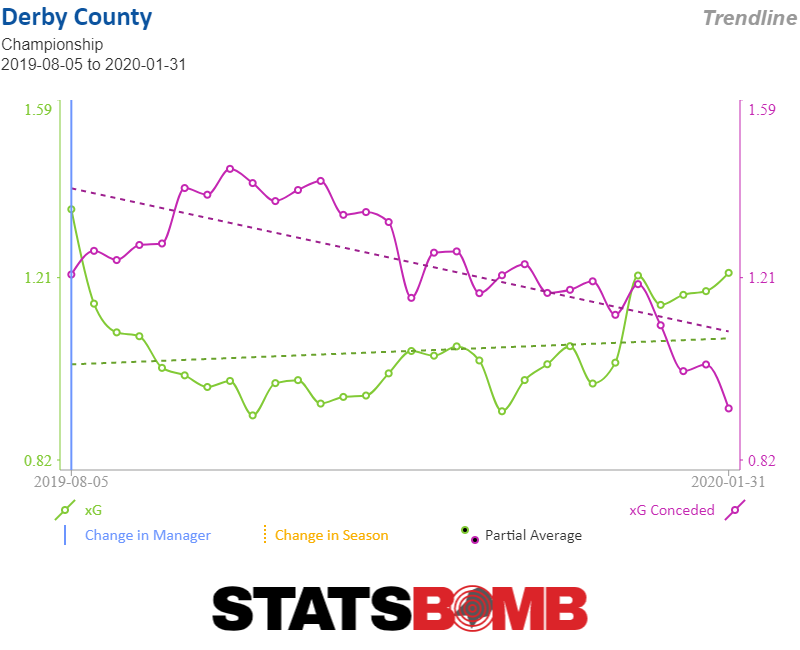 All in all, Cocu’s had a frankly ridiculous set of off-field distractions to wrestle with this season, none of which he is responsible for. Is he maximising the team at the moment? Probably not. Is it reasonable to expect him to be doing so given the circumstances he’s had to manage under? Definitely not. https://twitter.com/fplredrobin/status/1224391817388613642 I’ll let you be the judge.
All in all, Cocu’s had a frankly ridiculous set of off-field distractions to wrestle with this season, none of which he is responsible for. Is he maximising the team at the moment? Probably not. Is it reasonable to expect him to be doing so given the circumstances he’s had to manage under? Definitely not. https://twitter.com/fplredrobin/status/1224391817388613642 I’ll let you be the judge. 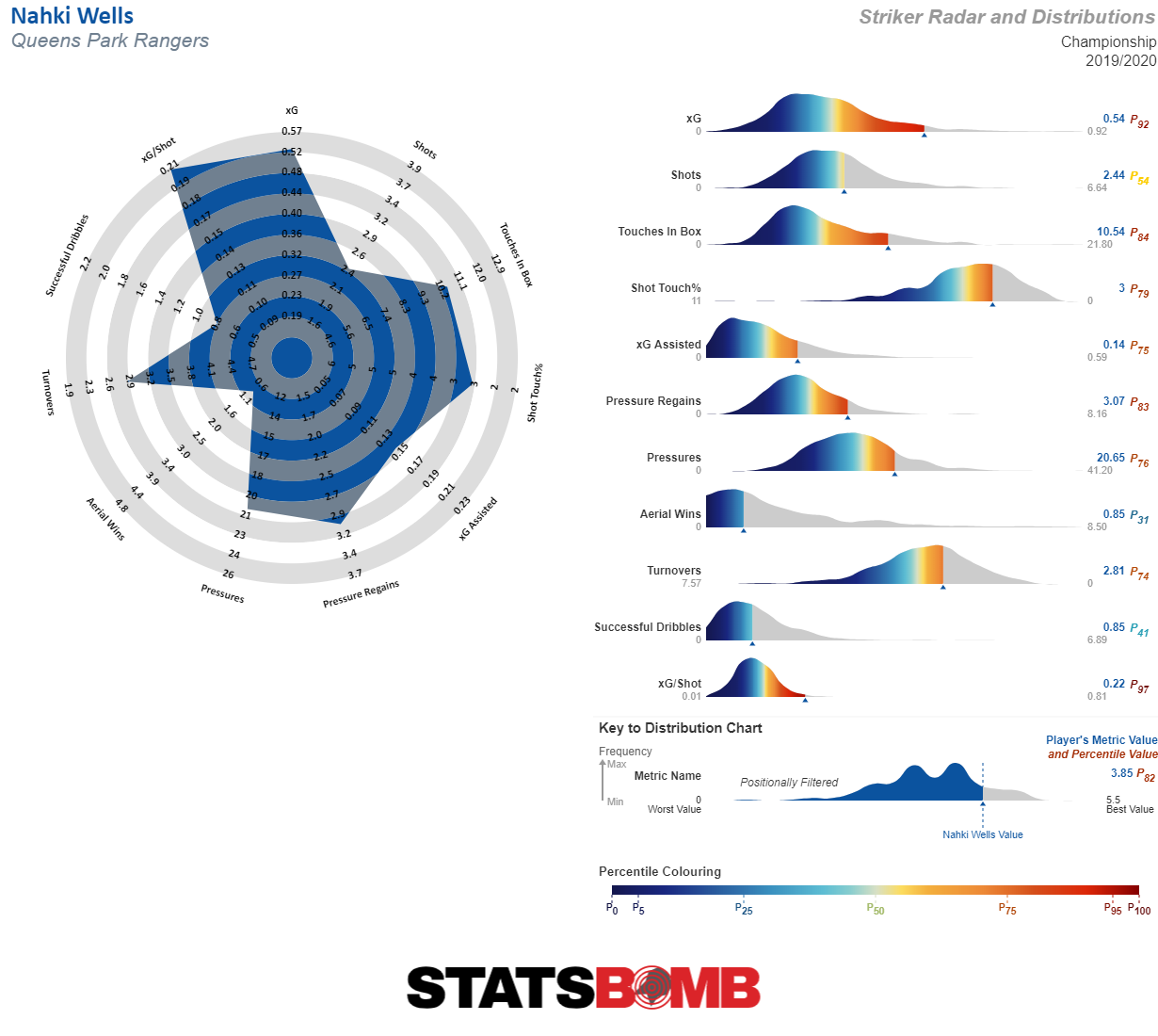 https://twitter.com/dgouilard/status/1224336891769524232 There’s been a pretty hefty decline in Preston’s results as the season’s progressed, and a couple of factors go a long way to explaining it. To start with, Preston’s season can pretty much be chopped in two: pre- and post-November 9th.
https://twitter.com/dgouilard/status/1224336891769524232 There’s been a pretty hefty decline in Preston’s results as the season’s progressed, and a couple of factors go a long way to explaining it. To start with, Preston’s season can pretty much be chopped in two: pre- and post-November 9th.
- Pre-November 9th, their record was P16 W9 D4 L3. Points per game: 2.06
- Post-November 9th, it’s P14 W4 D4 L6. Points per game: 1.14
The first explanation is that Preston were +8 in penalties in the opening 16 fixtures (8 won, 0 conceded) — the next best in the league was 4. So, whilst Preston were setting a good standard on the pitch in that time, their results received a boost thanks to their run of winning penalties. In the 14 games since that time, Preston’s penalty difference is -4 (0 won, 4 conceded). That swing goes a long way to explaining such a dramatic drop off in points. The other, more nuanced, but equally disruptive factor is the injuries Preston picked up prior to and during their run of four defeats up to early December. Defensive jewel Ben Davies dropped out, before big midfield influencers Paul Gallagher and Daniel Johnson both served time on the sideline. Maybe I’m over-simplifying, but it does seem that early on Preston were benefitting from a hot run of penalties and a settled side that allowed them to maximise their results. Winning fewer penalties and losing two or three key players — particularly at Preston where they lack the squad depth of their more financially-flush rivals — over a stretch of games will inevitably lead to a downturn in both on-pitch performances and results. Their current position of 7th is probably a fair reflection of their true ability anyway. https://twitter.com/EmilioPepilio/status/1224364186580529158 I’m not quite sure how to answer this when I regularly find myself asking the same first question myself, but here goes. At the start of the season, Leeds looked exceptionally good — better than last season and quite considerably ahead of anyone else in the league. Results were good, but the scoreline was tighter in a few games than Leeds’ domination suggested it should have been. The main issue, as raised, is the attack. After 21 games, Leeds had conceded just 10 goals, a fair reflection or their performances as captured by stats. They were a defensive machine. That they weren’t further ahead in the league table was down to squandering chances that would’ve turned some losses into draws and some draws into wins. But then Leeds won seven games in a row between November and December, and everyone collectively stopped scratching their heads; we’d all seen this coming. The Leeds machine was finally taking teams apart like they always threatened they were going to. I raise all this because the slump they’re currently enduring is not because they’ve started squandering chances again. The finishing ain't the problem anymore. It should be obvious to anyone: The issues are at the back. In the 9 fixtures since their winning run ended, they’ve conceded 17 goals. Their shots conceded per game rose from 8.67 to 10.22, fairly negligible but a downturn nonetheless. More alarming is that their xG per shot conceded increased from 0.07 to 0.11. 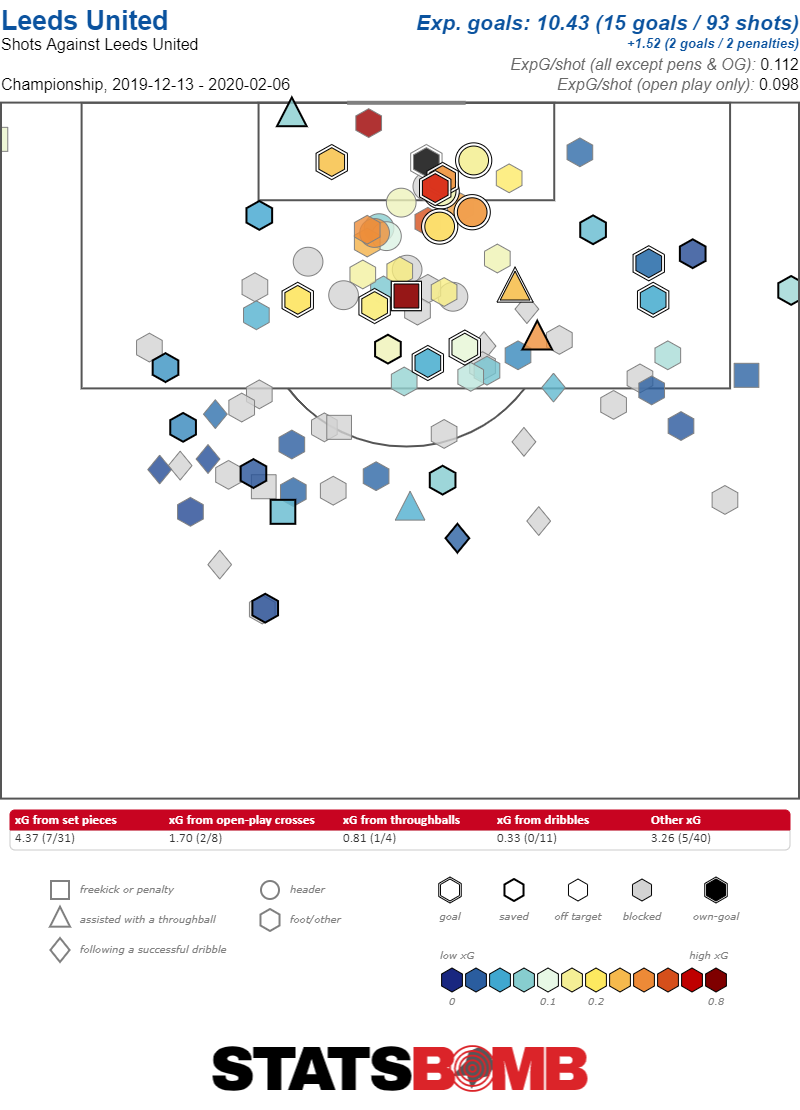 So we’re now faced with the double whammy of Leeds objectively performing worse defensively (albeit over a small sample of games) and Kiko Casilla having a slump in form between the sticks. Whether this continues largely depends on the reasons for the drop off. Have the players finally been exhausted by Marcelo Bielsa’s methods after 18 months at the helm, as some people suggest? Maybe? It could also be a simple wobble in performance. Whilst Leeds don’t look as daunting as they did earlier in the season, they still look promotion-contender levels of good. Whether their promotion bid is successful depends on whether the gradual decline in performances continues or whether the machine is just suffering a blip and resumes normal service in time. One wonders if Bielsa has tried turning his robots off and on again. https://twitter.com/analytic_footy/status/1224372797360820225 The trendline since the start of Bielsa’s reign certainly fuels the argument that Leeds are fudging xG somehow. Results have routinely struggled to keep up with performances.
So we’re now faced with the double whammy of Leeds objectively performing worse defensively (albeit over a small sample of games) and Kiko Casilla having a slump in form between the sticks. Whether this continues largely depends on the reasons for the drop off. Have the players finally been exhausted by Marcelo Bielsa’s methods after 18 months at the helm, as some people suggest? Maybe? It could also be a simple wobble in performance. Whilst Leeds don’t look as daunting as they did earlier in the season, they still look promotion-contender levels of good. Whether their promotion bid is successful depends on whether the gradual decline in performances continues or whether the machine is just suffering a blip and resumes normal service in time. One wonders if Bielsa has tried turning his robots off and on again. https://twitter.com/analytic_footy/status/1224372797360820225 The trendline since the start of Bielsa’s reign certainly fuels the argument that Leeds are fudging xG somehow. Results have routinely struggled to keep up with performances. 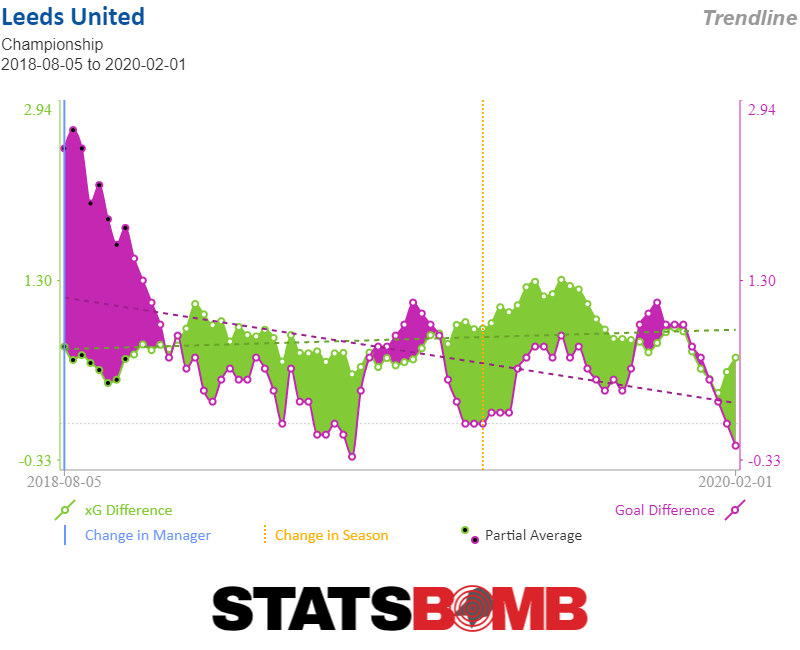 However, we’ve all seen the chances that Patrick Bamford and others have missed this season. The amount of ‘you simply have to score those’ chances that they've squandered is borderline comical. Which, for me, rules out any blind spots in the model. Bielsa’s system is lining these chances up for players, ‘tis the individual who is not finishing them. https://twitter.com/LukeSouthworth/status/1224330860905881601 To round things off I’ll answer with my underrated player because it’s easy. Ladies and gentlemen, Mathieu James Patrick Smith.
However, we’ve all seen the chances that Patrick Bamford and others have missed this season. The amount of ‘you simply have to score those’ chances that they've squandered is borderline comical. Which, for me, rules out any blind spots in the model. Bielsa’s system is lining these chances up for players, ‘tis the individual who is not finishing them. https://twitter.com/LukeSouthworth/status/1224330860905881601 To round things off I’ll answer with my underrated player because it’s easy. Ladies and gentlemen, Mathieu James Patrick Smith. 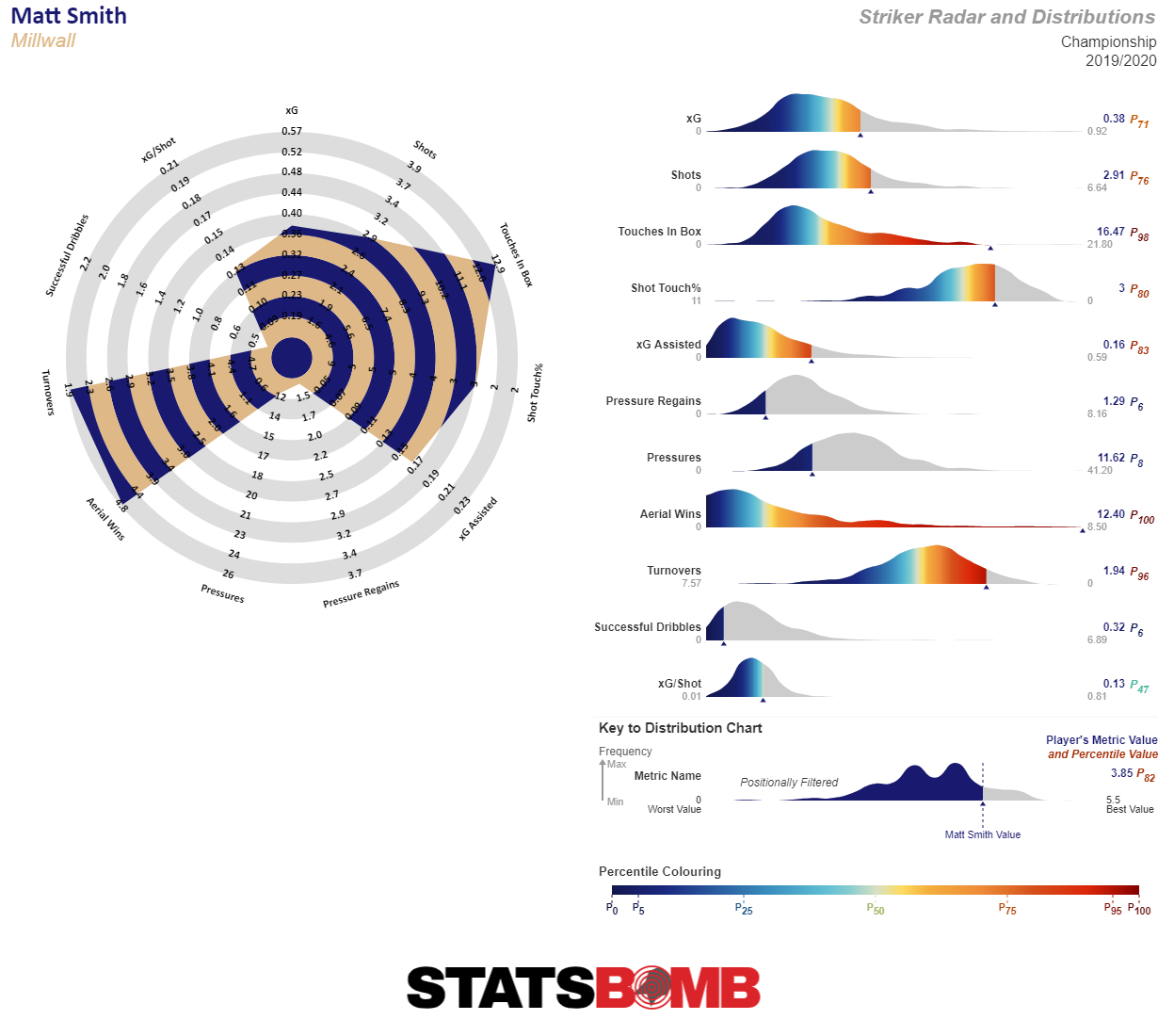 In the 100th percentile for aerial wins. The best Plan B in the league. Pure battering ram. Show me a defender who can consistently beat him in the air and I’ll show you a liar. Case closed. https://twitter.com/mixedknuts/status/1224336330747973632 We end with some health advice from the CEO because after all, your health is your wealth. 'Till next time, folks.
In the 100th percentile for aerial wins. The best Plan B in the league. Pure battering ram. Show me a defender who can consistently beat him in the air and I’ll show you a liar. Case closed. https://twitter.com/mixedknuts/status/1224336330747973632 We end with some health advice from the CEO because after all, your health is your wealth. 'Till next time, folks.